Need Amplification, But Not Yet Ready for a Hearing Aid?
If you have a hearing problem but don’t think you’re ready for a hearing aid, the BeHear NOW headset is a great halfway house.
So writes Mark Sparrow, Senior Contributor of Consumer Tech for Forbes. Mr. Sparrow is a technology journalist specializing in audio, computing and photography, and he has written a detailed review of the BeHear NOW assistive hearing headset.
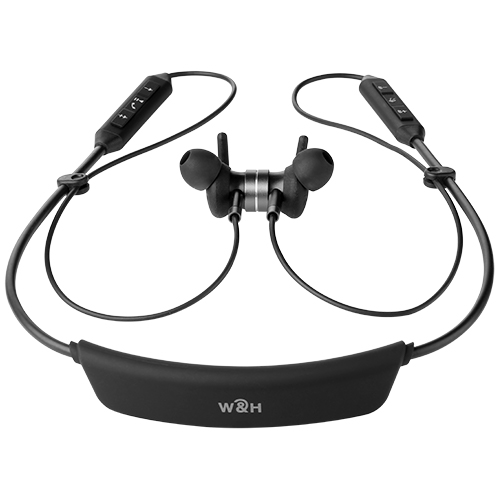
In summary, Mr. Sparrow writes: “The BeHear NOW headset is a very clever device that really can help with hearing problems. It’s ideal for TV, cinema, lectures and even social occasions if you can bear chatting while wearing earphones. The product is well made, and a lot of thought has gone into it and the app. The audio quality is very good thanks to the large driver units in each earpiece.”
How to Know if BeHear NOW Suits Your Level of Hearing Loss
Have you invested in hearing aids, only to discover that they don’t suit you in every situation? Maybe they’re too uncomfortable to wear all day, or they don’t really help you at the theater or during a live concert? Perhaps they help amplify sound, but they don’t help you understand mobile phone conversations, or hear the dialogue on the television very clearly?
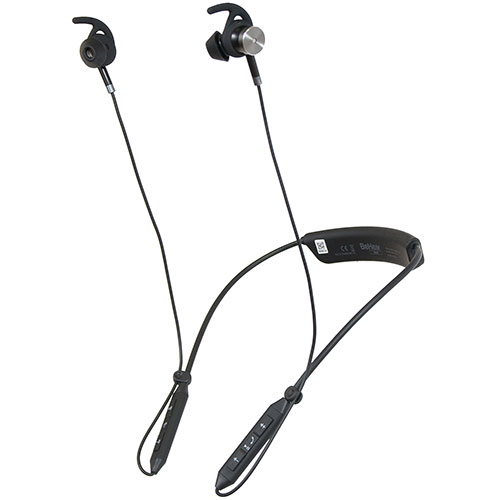
In these cases, you may be interested in trying BeHear NOW. This assistive hearing headset is not a medical device. Instead, it uses advanced sound processing technology, housed in a Bluetooth stereo headset, to enhance what you hear — whether it be live conversations, dialogue on the television, mobile phone calls — when you need it.
So, how do you know if a BeHear hearing amplifier would be right for you? We encourage you to try BeHear for yourself. We have a 30-day return policy, so if you’re not satisfied you simply return the product and get your money back.
What to Do Now
Go to our on-line shop and purchase a BeHear headset. Once you receive it you should go to the Google Play Store (for Android phones, version 4.4 and up) or the Apple Store (for iOS, version 9 and up) and download the free “W&H BeHear” app. You’ll use this app to pair your phone to the headset, and input the values from your audiogram (in the “Personal Info” section of the app). Once you finish, the headset will be updated automatically with custom parameters reflecting your hearing levels for the three hearing modes (ambient hearing, Bluetooth audio, and mobile phone calls). You can further customize the hearing presets (Indoor, Outdoor, Crowd and Live Music) in real-time using the app. View our library of “How to…” videos to learn how to use the headset.
If you’re still unsure…
We invite you to send us your audiogram and we will help determine if the BeHear hearing amplifier might be able to enhance your hearing.
Better Hearing is Now Within Reach – Part 3
This is the final installment of a 3-part series. If you haven’t yet read the earlier installments, you can read the first part here and the second part here.
How is this Concept Different from the Conventional Solutions?
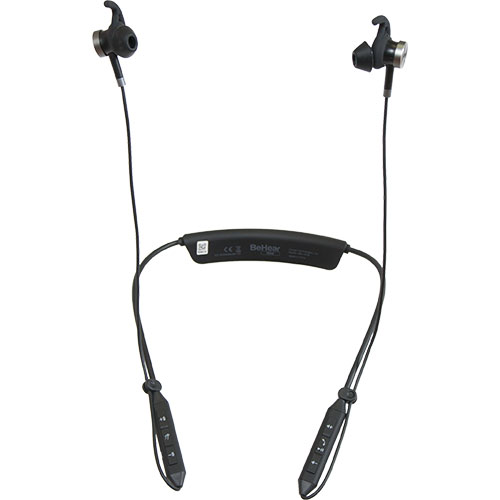
Our first personal hearing product, released commercially in the Fall of 2018, is called BeHear® NOW. It is a stylish, comfortable, high-quality Bluetooth stereo neckband style headset that can be used to listen to music or make phone calls. In addition, it can be used to enhance ambient hearing, very similar to or better than hearing aids. Its retail price of $249 ( €249) makes it very attractive to a wide population.
What About Sound Quality?
BeHear NOW has four microphones, two in the earpieces and two in the control boxes. Using four microphones enables unprecedented sound quality for both ambient hearing and voice communication. The headset features two 13mm hi-fi speakers delivering uncompromised sound. It includes a large rechargeable battery allowing the wearer to use its ambient hearing amplification during an entire day without recharging.
The Difference is in the Sound Enhancing Software
BeHear NOW can be used as a standalone hearing amplifier, but its true value comes with its software. It pairs with a dedicated, free smartphone application called W&H BeHear for iPhones and Android that enables full control and self-adjustment of the headset. When the personal hearing mode is activated, the wearer can choose the most suitable preset (Indoors, Outdoors, Crowd or Live Music). S/He can change noise reduction settings from low to maximum depending on the environment.
Fine Tune the Device on Your Own
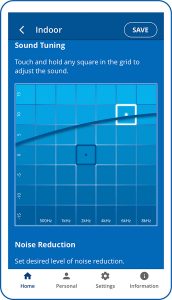
One of the problems with hearing aids today is that they require professional fitting in an audiologist’s office. Given the large number of people who suffer from hearing loss worldwide, it should be apparent that there are not enough audiologists on earth to provide hearing aids to everyone who needs one, especially in rural, distant areas. With BeHear NOW that is not an issue. Wearers can modify the spectrum of the sound they hear in real time by moving their finger on a grid to locate what we call the Best Sound Point. The Best Sound Point is a highly personal definition, depending on the wearer’s preferences, capabilities, and current location!
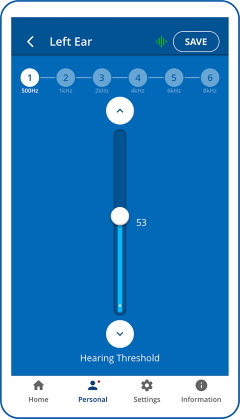
Furthermore, the W&H BeHear application contains a simple hearing assessment that anyone can perform and get immediate results. This is not a medical procedure, of course, but when completed, all BeHear NOW sounds will be modified to fit the wearer’s own personal hearing profile.
Advantages That People With Normal Hearing Will Also Appreciate
BeHear NOW also includes some advanced features that may be useful for people with normal hearing as well. For example, many people have trouble with fast speech. We all prefer that the other person speak slower when we need to write down a phone number, understand a foreign language, or are otherwise being distracted. BeHear NOW can do it automatically. When BeHear NOW is used to make or take a phone call, the wearer can activate a special mode called EasyListen™ to slow down speech and improve understanding. While listening to music, the wearer can activate ListenThrough™ technology. Nearby human voices, the noise of an approaching car and other important or alarming sounds will pass through while ambient noise will be blocked, allowing him/her to enjoy the music to the fullest.
Use EasyListen on mobile calls to slow down speech and improve understanding. Stay safe and alert, even while using your mobile phone in noisy places.
Great Potential for Improving Quality of Life
The Wear & Hear line of assistive hearing products is highly innovative, leveraging two successful concepts (consumer electronics and sound technology advancements). The resulting solutions have the potential to improve quality of life for millions of people worldwide. As Helen Keller once famously remarked, when asked which sense was more important, vision or hearing: “Blindness cuts us off from things, but deafness cuts us off from people.” We want the world to sound better to all. With the aid of our personal hearing devices, people can reconnect socially, without the stigma or high cost of a medical hearing aid.
What’s Next? Feedback and Market Education
The first members of our Wear & Hear family of personal hearing devices are ready for purchase, here on our Web site, and through our international partner channel. However, the market needs educating. There are about 400 million people with disabling hearing loss who desperately need a solution, but they have no idea that there is a high-quality alternative to hearing aids. Our concept of affordable, stylish, multi-functional hearing enhancement solutions needs to capture the attention of both the hearing impaired and those who can help us bring them to market. Can you help?
Better Hearing is Now Within Reach – Part 2
This is the second installment of a 3-part series. If you haven’t yet read the first installment, you can read it here.
An Unorthodox Approach Brings Hope
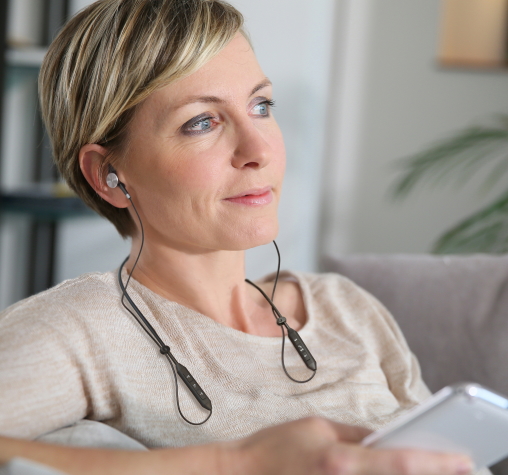
The development trend for hearing aids throughout history has been to make the devices smaller and less noticeable. We, on the other hand, wanted to make our hearing enhancement devices stylish, and even fashionable. Instead of making them expensive medical devices, we wanted to make them affordable consumer electronics devices. In addition, we wanted our devices to be high performance and multi-functional. And finally, we wanted our devices to act as hearing protectors by reducing loud ambient noises to safe levels.
Consumer Electronics Can Serve a Wider Purpose
We chose a Bluetooth headset as a basic form factor for our hearing enhancement device concept due to its ubiquity. Its cost of goods is low and public acceptability is high. In order to transform it into a powerful hearing enhancement device we first investigated its existing components, and found:
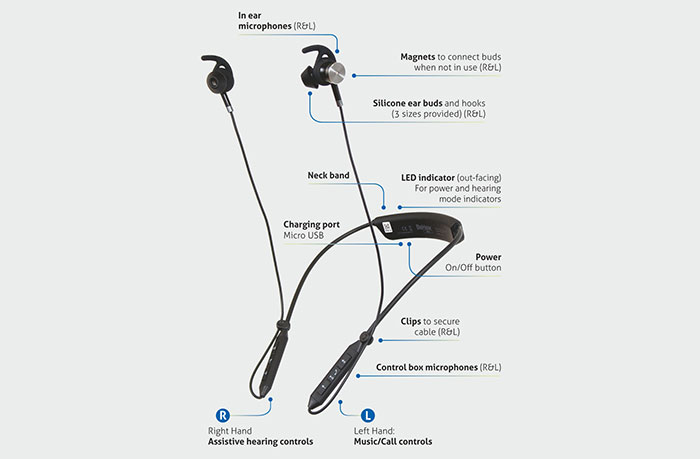
- At least one microphone. In many Bluetooth headsets we can find a dual microphone, something relevant to high end hearing aids only.
- A high-quality speaker that is much better than that of hearing aids, due to their size limitations.
- A Digital Signal Processor that is 4-5 times more powerful than that of most of hearing aids.
- Bluetooth connectivity present only in the latest, greatest and most expensive hearing aids
- An environmentally friendly rechargeable battery
The Missing Component: Hearing Enhancement Software

That means that there is only one important piece missing to transform ANY Bluetooth headset into a powerful hearing enhancement device. This piece is software. Just do it, and you have exciting news for more than 1 billion hearing impaired people world-wide. Since we are a software sound processing company, we did it! We created a licensable software reference design that makes it possible to add hearing enhancement functionality to virtually any Bluetooth headset. We call our solution Hearphones™.

In order to be sure that our solution was good, and that it really could help hearing impaired people as well as or better than hearing aids, we decided to go one step further. We decided to create our own brand of concept products that we call Wear & Hear, with our slogan “Life Sounds Better”.
How Does this Approach Compare to Conventional Solutions?
In the next post in this “Hearing Better is Now Within Reach” blog series, we’ll compare this unorthodox approach with the conventional solutions.
Better Hearing is Now Within Reach – Part 1
The Need, the Conventional Solution, and the Despair
The World Health Organization estimates that approximately 15% of the world’s population (that’s around 1.2 billion people!) suffers from hearing loss of greater than 25 decibels. Even though hearing loss is typically associated with old age, the majority of sufferers are under the age of 65. It is well known that hearing loss is a terrible experience for an individual and has multiple consequences. Children with hearing loss are likely to experience delayed speech development, impaired communication and reduced cognitive skills. In adults, hearing loss has been linked to poorer job performance and, as a result, lower salaries. In the elderly, hearing loss is associated with an increased risk of dementia, falls, depression, social isolation and loneliness. These problems impose a heavy financial burden on the society.
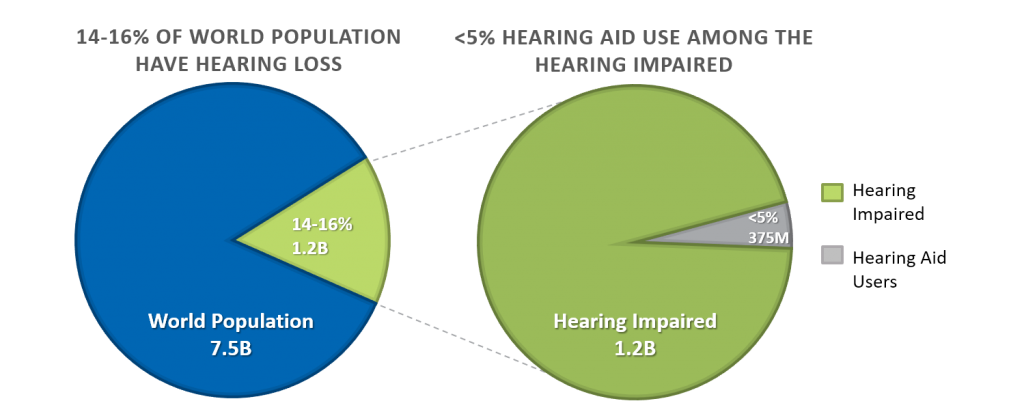
There is good news, though. Research shows that 95% of hearing impaired people can be helped by hearing amplification. The solution that jumps to mind immediately is hearing aids. Hearing aids have a long history: from hearing trumpets used over 100 years ago, through the development of the first wearable electronic devices, to the modern era of small, digital devices of various styles. Yet, hearing aids are used by less than 20% of hearing impaired people in developed countries, and less than 3% in low income countries. Why?
Why Aren’t More People Using Hearing Aids?
- Extremely high cost. A pair of hearing aids costs between $2000-$8000 dollars. Unless it is fully covered by insurance, it is not surprising that most people hesitate before buying them.
- Social stigma. Justified or not, people feel that wearing hearing aids will make them look older or handicapped. It is interesting that this feeling does not actually depend on the age. Many elderly people refuse to wear hearing aids. We all want to be young.
- Limited functionality. We’re used to multi-functional electronic devices that can do much more than just their main functionality. Smartphones are a classic example, but we have others, such as: radios, smartwatches or fitness bracelets. Basic, reasonably priced hearing aids can only do voice amplification.
- Performance. 20% of people who buy hearing aids return them. Although they are badly needed, these devices don’t help them. 17% of those who decide to keep their hearing aids are not satisfied.
What Can Be Done to Surmount These Obstacles to Better Hearing?
In the next post in this “Hearing Better is Now Within Reach” blog series, we’ll look at an unorthodox approach that addresses all four of these obstacles to bring hope to those experiencing mild to moderate hearing loss.

